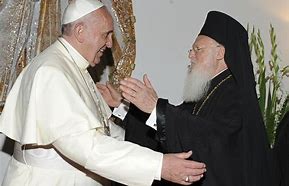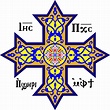 |
 |
 |
 The Coptic Catholic Church
The Coptic Catholic Church
A formal union between the Catholic and Coptic Orthodox churches took place with the signing of the document Cantate Domino by a Coptic delegation at the Council of Florence on February 4, 1442. But, because this act was not supported in Egypt, it had no concrete results.
Catholic missionaries were first active among the Copts in the 17th century, with the Franciscans in the lead. A Capuchin mission was founded in Cairo in 1630, and in 1675 the Jesuits began missionary activity in Egypt. During the same century a number of lengthy but fruitless theological exchanges took place between Rome and the Coptic Church.
In 1741 a Coptic bishop in Jerusalem, Anba Athanasius, became a Catholic. Pope Benedict XIV appointed him Vicar Apostolic of the small community of Egyptian Coptic Catholics, which at that time numbered no more than 2,000. Although Athanasius eventually returned to the Coptic Orthodox Church, a line of Catholic Vicars Apostolic continued after him.
In 1824, under the mistaken impression that the Ottoman viceroy wished it to do so, the Holy See erected a Patriarchate for Coptic Catholics, but it existed only on paper. The Ottoman authorities permitted the Coptic Catholics to begin building their own churches only in 1829.
In 1895 Leo XIII re-established the Patriarchate and in 1899 he appointed Bishop Cyril Makarios as Patriarch Cyril II "of Alexandria of the Copts" As Patriarchal Vicar Bishop Cyril had presided over a Catholic Coptic synod in 1898 which introduced a number of Latin practices. He became embroiled in controversy, and was asked by the Holy See to resign in 1908. The office remained vacant until 1947, when a new Patriarch was finally elected.
The offices of the Patriarchate are located in Cairo, but the largest concentration of Coptic Catholics has always been in upper Egypt. In recent times there has been some migration to other parts of the country. The church now has seven dioceses, all of them in Egypt.
Most candidates for the priesthood are trained at St. Leo's Patriarchal Seminary in Maadi, a suburb of Cairo. It was founded in 1953 and had 52 students in 2006. More than 100 Coptic Catholic parishes administer primary schools, and some have secondary schools as well. The church maintains a hospital in Assiut, a number of medical dispensaries and clinics, and several orphanages.
There are no Coptic Catholic monasteries to rival the Coptic Orthodox monastic tradition. However, in 2006 there was an Egyptian province of the Franciscans dependent on the Patriarchate (58 priests, 12 brothers, four novices and 27 seminarians), along with three female religious orders: the Egyptian Sisters of the Sacred Heart (62 professed, 12 novices and 40 postulants), the Coptic Sisters of Jesus and Mary (44 professed, six novices and one postulant), and an Egyptian province of the Little Sisters of Jesus (seven professed, one novice).
Like their Orthodox counterparts, Coptic Catholics have begun to emigrate to western countries in larger numbers in recent years. There are now 11 communities in various parts of the world, each of them served by a priest: two in Italy, one in France, two in Canada, three in the United States, two in Australia, and one in Kuwait. In addition, the Archbishop of Beirut serves as Ordinary for Coptic Catholics in Lebanon.
Location: Egypt, small diaspora
Head: Patriarch Ibrahim Isaac Sidrak (born 1955, elected 2013)
Title: Patriarch of Alexandria of the Copts
Residence: Cairo, Egypt
Membership: 162,000
Last Modified: 06 Feb 2013